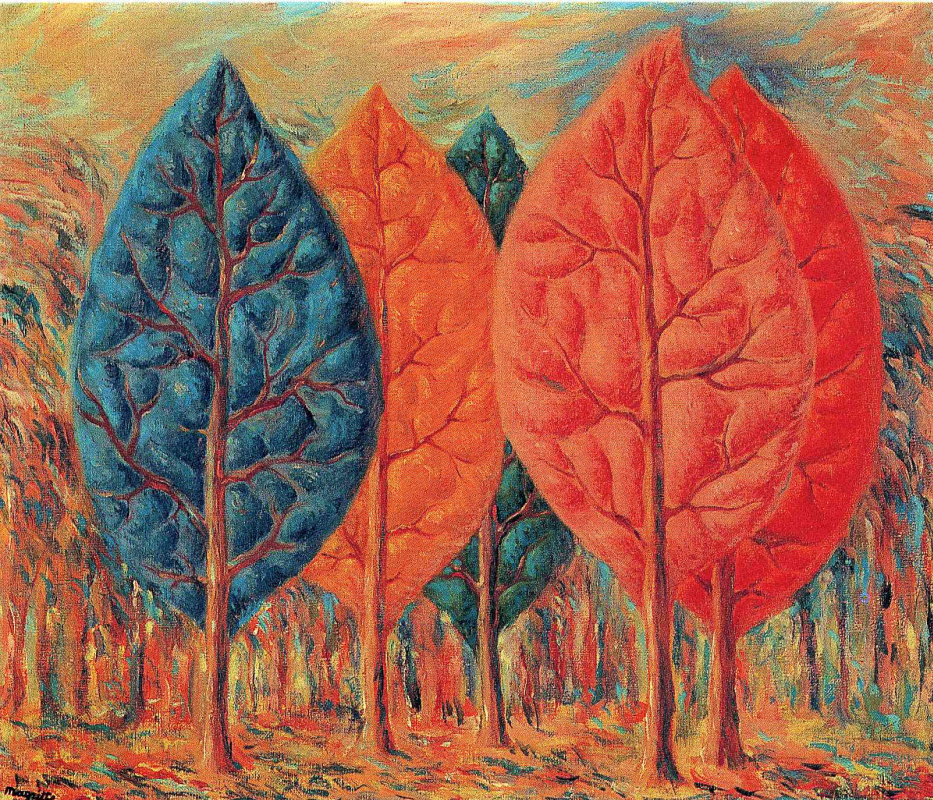log in
Enter site
Login to use Arthive functionality to the maximum
Flame
René Magritte • Painting, 1943, 54×65 cm
Description of the artwork «Flame»
"Flame" - a painting painted by Magritte in 1943 during the German occupation of Belgium. Unlike many surrealist colleagues who went to wait out the troubled times overseas (like Dali and Gala - to America), he preferred to stay at home.
During the war years, the artist deviated somewhat from his corporate style: he believed that his art should cheer people up in difficult times and inspire, if not joy, then at least optimism. He deliberately turned to a brighter palette and was even inspired by impressionist developments (1, 2, 3). Despite his good intentions, these works of his often sounded more anxious than carelessness and bliss. Magritte called the works of this period "sunny surrealism", but critics were not happy with this turn in his work.
“Flame” is an illustrative example in this respect: the painting contains both recognizable Magritte trees in the form of leaves, and an uncharacteristic wry-eyed background, more reminiscent of Renoir's legacy. Although in this work, the bouncy impressionist brushstrokes do not look life-affirming at all - on the contrary, it seems that this surreal forest is on fire. The title of the picture suggests that the effect is not accidental: apparently, despite all the artist's efforts to resist the gloomy mood of wartime, reality nevertheless made adjustments to his worldview and creative impulses.
Even tree leaves, usually so fragile and delicate in Magritte's paintings (1, 2), look like lumps of flesh speckled with veins swollen with blood. For the first time the artist came to such a tree shape in 1935 and since then has repeatedly used it in different color variations, and sometimes even leaving only an openwork frame, as in the painting "The Lost Jockey" (version 1948 year).
Magritte did not immediately come to this laconic form. He shared the details of his search in a letter to André Breton dated July 1934: "At the moment I am trying to find out what exactly in the tree belongs to him, but it will contradict our idea of a tree."... There he also wrote about his solution to the problem: "The tree has become a large leaf, the stem of which has become a trunk planted directly in the ground.".
Jacques Meuris in his book "Rene Magritte" spoke about the artist's treatment of natural objects: “Nature, as Magritte saw it, was an element with the same characteristics as those with which he endowed every object, every thing. In his work there were no "naturalistic" tendencies, no ecological impulse, or even a poetic transformation of nature. Nevertheless, trees and leaves, singly or in groups, clothed or naked, sometimes tainted by insects, can be regarded as "individuals" endowed with a variety of senses, gifted with enchantments in different senses of the word. ".
The author: Natalia Azarenko
During the war years, the artist deviated somewhat from his corporate style: he believed that his art should cheer people up in difficult times and inspire, if not joy, then at least optimism. He deliberately turned to a brighter palette and was even inspired by impressionist developments (1, 2, 3). Despite his good intentions, these works of his often sounded more anxious than carelessness and bliss. Magritte called the works of this period "sunny surrealism", but critics were not happy with this turn in his work.
“Flame” is an illustrative example in this respect: the painting contains both recognizable Magritte trees in the form of leaves, and an uncharacteristic wry-eyed background, more reminiscent of Renoir's legacy. Although in this work, the bouncy impressionist brushstrokes do not look life-affirming at all - on the contrary, it seems that this surreal forest is on fire. The title of the picture suggests that the effect is not accidental: apparently, despite all the artist's efforts to resist the gloomy mood of wartime, reality nevertheless made adjustments to his worldview and creative impulses.
Even tree leaves, usually so fragile and delicate in Magritte's paintings (1, 2), look like lumps of flesh speckled with veins swollen with blood. For the first time the artist came to such a tree shape in 1935 and since then has repeatedly used it in different color variations, and sometimes even leaving only an openwork frame, as in the painting "The Lost Jockey" (version 1948 year).
Magritte did not immediately come to this laconic form. He shared the details of his search in a letter to André Breton dated July 1934: "At the moment I am trying to find out what exactly in the tree belongs to him, but it will contradict our idea of a tree."... There he also wrote about his solution to the problem: "The tree has become a large leaf, the stem of which has become a trunk planted directly in the ground.".
Jacques Meuris in his book "Rene Magritte" spoke about the artist's treatment of natural objects: “Nature, as Magritte saw it, was an element with the same characteristics as those with which he endowed every object, every thing. In his work there were no "naturalistic" tendencies, no ecological impulse, or even a poetic transformation of nature. Nevertheless, trees and leaves, singly or in groups, clothed or naked, sometimes tainted by insects, can be regarded as "individuals" endowed with a variety of senses, gifted with enchantments in different senses of the word. ".
The author: Natalia Azarenko


